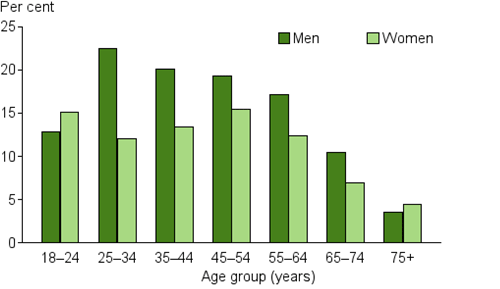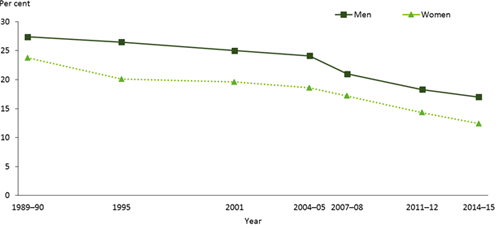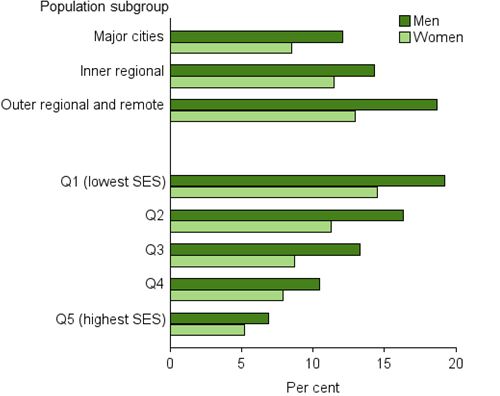Tobacco smoking
Smoking is the single most important preventable cause of ill health and death in Australia [1]. Tobacco smoke contains over 7,000 chemicals, of which over 70 cause cancer. When tobacco smoke is inhaled, these chemicals enter the lungs and spread through the body via the lymphatic system [2].
Smoking is linked to a range of conditions including various cancers, cardiovascular diseases, type 2 diabetes, hip fractures and reproductive problems in women [2]. Inhaling environmental tobacco smoke or second-hand smoke [3] is also associated with harmful effects.
A number of nationally representative data sources are available to analyse recent trends in tobacco smoking. The Australian Institute of Health and Welfare (AIHW) National Drug Strategy Household Survey (NDSHS) and the Australian Bureau of Statistics (ABS) National Health Survey (NHS) have both collected data on tobacco smoking from people aged 18 or over for a number of years. The NHS also collected data from people aged 15–17 from 2007–08 and the NDSHS also collected data from people aged 14–17 from 1985 and from people aged 12–13 from 2004.
Comparisons of data from the NDSHS and NHS show variations in estimates for tobacco smoking, but similar trends. For more information on the technical details of these two surveys, please see technical notes. In this section, total population prevalence estimates and trends are presented for both the NHS and NDSHS, however the remainder of the results by age and population groups are derived from the NHS to ensure consistency in the data source for all risk factors presented here.
Box 1: How is tobacco smoking measured?
Tobacco smoking is the smoking of tobacco products, including packet cigarettes, roll-your-own cigarettes, cigars or pipes.
The Australian Bureau of Statistics (ABS) 2014—15 National Health Survey (NHS) collected information on tobacco smoking from approximately 19,000 respondents [4].
The 2016 National Drug Strategy Household Survey (NDSHS) collected information from almost 24,000 people across Australia on their tobacco, alcohol and illicit drug use, attitudes and opinions [5].
In both surveys, people were asked whether they had ever smoked, whether they were ex-smokers or had never smoked, and about the frequency of their smoking and the quantity and type of tobacco smoked.
Since daily smoking presents the greatest health risk, the results presented here relate to adults aged 18 and over who reported being daily smokers at the time of the survey.
Who currently smokes?
Based on self-reported data from the ABS 2014–15 NHS, about 1 in 7 people aged 18 and over (14.5%) smoked daily. Overall, a higher proportion of men (16.9%) smoked than women (12.1%).
Based on self-reported data from the 2016 NDSHS, a slightly lower proportion—about 1 in 8 people aged 18 or older—were daily smokers (12.8%). A higher proportion of men (14.6%) smoked daily than women (11.2%)[5].
After adjusting for differences in the age structure of the population over time, both surveys showed a decline in the rate of daily smoking among adults over a similar period.
- For the NHS daily smoking rates decreased from 19.1% in 2007–08 to 14.7% in 2014–15.
- For the NDSHS daily smoking rates decreased from 17.5% in 2007 to 12.8% in 2016.
Smoking by age and sex
Based on the results of the ABS 2014–15 NHS, the greatest difference between the sexes was among 25–34 year olds where smoking among men was at its highest (22.5% compared with 12.1% for women) (Figure 1).
Among older people, daily smoking rates decreased with age and were lowest at age 75 and over—3.6% for men and 4.5% for women.
Figure 1: Prevalence of daily smoking in persons aged 18 and over, by sex, 2014–15

Source: ABS 2015. National Health Survey: First Results, 2014–15. ABS cat. no. 4364.0.55.001. Canberra: Australian Bureau of Statistics (see source data).
Trends in daily smoking
In 1989–90, 27.4% of men and 23.8% of women aged 18 and over smoked daily, which fell to 17.0% for men and 12.4% for women in 2014–15 (age-standardised; Figure 2). Australia's suite of tobacco control measures have played a substantial role in reducing smoking prevalence among adults. These control measures include: stronger smoke-free laws, tobacco price increases, plain packaging of tobacco products, graphic health warning labels, provision of support for smokers to quit and greater exposure to mass media campaigns [6]. A decline in uptake of smoking in younger adults since 2001 may have also contributed to a reduction in smoking prevalence [5].
Figure 2: Prevalence of daily smoking in persons aged 18 and over, by sex, 1989–90 to 2014–15

Note: Age-standardised to the 2001 Australian population.
Source: AIHW 2012. Risk factor trends: age patterns in key health risk factors over time. Cat. no. PHE 166. Canberra: Australian Institute of Health and Welfare; and ABS 2015. National Health Survey: First Results, 2014–15. ABS cat. no. 4364.0.55.001. Canberra: Australian Bureau of Statistics (see source data).
Inequalities
The proportion of adults who smoke daily differs across geographic areas and socioeconomic groups (Figure 3). Adults in Outer regional and remote areas were 1.6 times as likely to be daily smokers as those in Major cities (20.9% compared with 13.0%).
Adults living in the most disadvantaged areas were 2.7 times as likely to smoke daily as those living in the least disadvantaged areas (21.3% compared with 7.8%).
Figure 3: Prevalence of daily smoking in persons aged 18 and over, by sex, by selected population characteristics, 2014–15

Note: Q1–Q5 refers to area-based quintiles of socioeconomic position, based on the ABS Index of Relative Socio-Economic Disadvantage (IRSD) [7].
Source: AIHW analysis of ABS Microdata: National Health Survey, 2014–15.
International comparisons
Daily smoking rates in Australia are around the lowest among Organisation for Economic Cooperation and Development (OECD) countries. In 2014 (or the nearest year), 13.0% of the population aged 15 and over in Australia smoked, compared to 19.0% in the United Kingdom, 14.0% in Canada and 12.9% in the United States. Australia's rate was well below the average across 34 OECD countries (19.3%) [8].
Source data
References
-
AIHW (Australian Institute of Health and Welfare) 2012. Risk factors contributing to chronic disease. Cat. no. PHE 157. Canberra: Australian Institute of Health and Welfare.
-
(USDHHS) U.S. Department of Health and Human Services 2014. The Health Consequences of Smoking—50 years of progress. A report of the Surgeon General. Atlanta: U.S. Department of Health and Human Services.
-
Eriksen M & Whitney C 2013. Risk factors: tobacco. In: McQueen DV (ed.). Global handbook on noncommunicable disease and health promotion. Springer, NY, 115-36.
-
ABS (Australian Bureau of Statistics) 2015. National Health Survey: First Results, 2014–15. ABS cat, no. 4364.0.55.001. Canberra: Australian Bureau of Statistics.
-
AIHW 2017. National Drug Strategy Household Survey (NDHS) key findings: 2016. Canberra: AIHW. Viewed 6 June 2017.
-
Wakefield MA, Coomber K, Durkin SJ, Scollo M, Bayly M, Spittal MJ et al. 2014. Time series analysis of the impact of tobacco control policies on smoking prevalence among Australian adults, 2001–2011. Bulletin of the World Health Organization 92:413-22.
-
ABS 2013. Census of Population and Housing: Socio-Economic Indexes for Areas (SEIFA). ABS cat. no. 2033.0.55.001. Canberra: Australian Bureau of Statistics.
-
OECD (Organisation for Economic Cooperation and Development) 2016. OECD Health Statistics 2016. Paris: Organisation for Economic Cooperation and Development Publishing. Viewed 29 June 2014.


